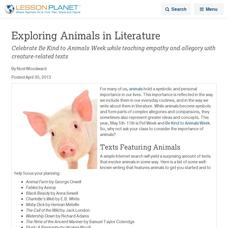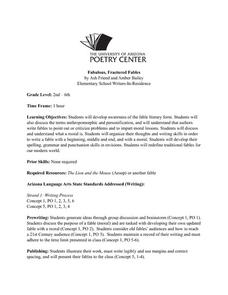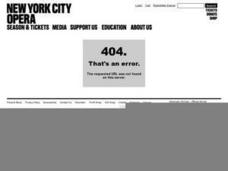Curated OER
Anthropomorphic Writing
In this writing worksheet, students discover anthropomorphic writing-- giving human characteristics to an inanimate object. Students write a short passage and draw a picture of a laughing leaf.
Curated OER
Exploring Animals in Literature
Celebrate Be Kind to Animals Week while teaching empathy and allegory with creature-related texts
Pittford Schools
Literary Devices, Techniques, and Elements
What's the difference between a speaker and an author? What's an example of anthropomorphism? Clarify the meanings of literary devices, elements, and techniques with a comprehensive glossary of terms.
Curated OER
Life's Lessons: Survival of the Fittest
Students analyze Jack London's use of anthropomorphism to identify the importance of adaptability in life. In this literature lesson, students use the novel The Call of the Wild to identify key elements in survival. Students...
EngageNY
Grade 9 ELA Module 3, Unit 1, Lesson 4
Can dogs feel shame? Explore the anthropomorphic connection between human emotions and animal behavior—or lack thereof—with a lesson about Temple Grandin's book, Animals in Translation. Ninth graders continue a close reading of chapter...
Reed Novel Studies
The Wind In The Willows: Novel Study
True friends stick together. In the case of The Wind In The Willows, the friends just happen to be a toad, mole, rat, and badger who team up to beat the weasels. The resource covers the first chapter of their raucous adventures. Scholars...
Curated OER
The Laughing Leaf
Students demonstrate real-object writing. They discuss a leaf that has human attributes, and using a real leaf write a story about a leaf that tells them a joke, and create an illustration of themselves and their leaf.
Curated OER
Fabulous, Fractured Fables
Elementary schoolers develop an awareness of the literary form known as the fable. They explore how authors write fables to pass along moral lessons. After reading and discussing many famous fables embedded in the plan, learners attempt...
Curated OER
Jack London's The Call of the Wild: "Nature Faker"?
Middle schoolers examine how Jack London tells a story from the point of view of an animal. They read and discuss primary source documents, analyze text and excerpts, complete a chart, and explore various websites.
Curated OER
Animal Rights Vs. Animal Welfare - Understanding the Issue
Pupils explore the difference between animal rights and animal welfare. They take a field trip to a farm to explore the producing animals for human use. After researching and collecting information from animal welfare/rights...
Curated OER
Jack London's The Call of the Wild: "Nature Faker"?
Students take a stand on whether or not London could be dubbed a "nature faker." They support their position with evidence either historical or from the text. Students write an essay, complete with hypothesis and textual support, on...
Curated OER
White Fang by Jack London
For this online interactive reading comprehension worksheet, learners respond to 6 short answer and essay questions based on White Fang. Students may also access an online quiz on the selection using the link at the bottom of the page.
Curated OER
The Call of the Wild Vocabulary Exercise
In this vocabulary activity, students match words to definitions and complete a word search for vocabulary from The Call of the Wild. Students complete 10 words for each exercise.
Curated OER
Honey Bee Language Arts And Literature
Students see how nature and honey bees are presented in literature. They find and read poetry that include references to bees. Have them write their own poetry or Haiku.
Curated OER
Greek Mythology: All in the Family
Twelfth graders compare/contrast the Greek myth to explain an aspect of nature. They create an explanatory myth about some aspect of nature and design a mythological business card using Microsoft Word.
Curated OER
Personification Stories
Students create a clay object in which they are to personify. They use their own personal experiences to help the viewer imagine what it would be like to be that particular object. They also watch videos of fables to help them with...
Curated OER
Transforming Anansi Folktales Into Storyboards
Students work in small groups to illustrate a story board of a folktale. They develop the meaning of a trickster as a humor device in folktales by listening to several about Leprechauns and the Coyote of Native American tales. They then...
Ted Nellen
Cyber English (By Ted Nellen): Anthropomorphism
This is a glossary entry for the term "Anthropomorphism" including definitions, examples, and a link to more information.
Sophia Learning
Sophia: Anthropomorphic Characterization
This lesson introduces anthropomorphic characterization in fiction writing.
Other
Anthropomorphism
A good, concise definition of anthropomorphism in mythologies, art and literature.
New Advent
Catholic Encyclopedia: Anthropomorphism, Anthropomorphites
An explantation of the literary terms Anthropomorphism and Anthropomorphites as they relate to religious philosophy. Please note that ?The Catholic Encyclopedia? is a historic reference source and should be viewed in the context of...
Blackdog Media
Classic Reader: The Wind in the Willows by Kenneth Grahame
This is the full text of the children's novel The Wind in the Willows by Kenneth Grahame. It focuses on four anthropomorphized animals in a pastoral version of Edwardian England and is notable for its mixture of mysticism, adventure,...
TES Global
Blendspace: Figurative Language 6th Grade
A seven-part learning module with links to websites, videos, and a chart about figurative language including simile, metaphor, alliteration, hyperbole, anthropomorphism, and idiom.
CommonLit
Common Lit: Elephant's Child
CommonLit.org is a wonderful resource to use in a Language Arts classroom. Each text is accompanied by guided reading questions, assessment questions, and discussion questions. In addition, students can click on words to see the...
























